 |
 |
Talgar - 5017 |
|
|
 |
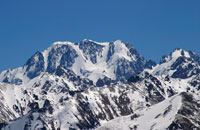 The Talgar River valley lies 25 km to the east of Almaty. It is a big river flowing down from the northern slopes of the Zailiiski Alatau Range , formed by two branches – the Levyi (“left”) Talgar on the west and the Pravyi (“right”) Talgar on the east. Another branch, the Srednyi Talgar, flows in the right source near its merger with the left branch.
The History of Peak of Talgar
Talgar was discovered by scientists back in the mid-19th century, however, the notorious confusion of the region’s orography, with identification of peaks as they are approached from The Talgar River valley lies 25 km to the east of Almaty. It is a big river flowing down from the northern slopes of the Zailiiski Alatau Range , formed by two branches – the Levyi (“left”) Talgar on the west and the Pravyi (“right”) Talgar on the east. Another branch, the Srednyi Talgar, flows in the right source near its merger with the left branch.
The History of Peak of Talgar
Talgar was discovered by scientists back in the mid-19th century, however, the notorious confusion of the region’s orography, with identification of peaks as they are approached from 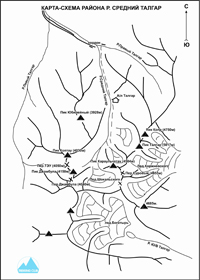 the the 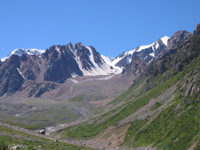 north or from the south, did not allow to succeed in climbing. north or from the south, did not allow to succeed in climbing.
It was not until 1935 that the mountain-climbers’ persistence was awarded. Having climbed the northern side of the massif, a group led by Kh. Rakhimov called the place Kopr. The same year, 12 young mountain-climbers led by V. Zimin conquered the south-western top ( 4,860 m ) in severe winter conditions. Three years after, people from Novosibirsk led by Ye. Alekseyev reached the 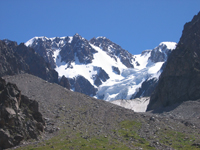 northern peak ( 5,000 m ) in a February cold and snowstorm. And finally, Siberians L. Katukhin, G. Makatrov and I. Kropotov won the highest peak of the “ Multicolored Mountains ”, the head peak of Talgar . It took the mountain-climbers three years to follow the easiest routes. northern peak ( 5,000 m ) in a February cold and snowstorm. And finally, Siberians L. Katukhin, G. Makatrov and I. Kropotov won the highest peak of the “ Multicolored Mountains ”, the head peak of Talgar . It took the mountain-climbers three years to follow the easiest routes.
During World War II, while training mountain sharpshooters, Colonel Gorin made a few ascents, and one of the Zailiiski Alatau peaks was named after him. A tragedy on the south-western slopes of PeakTalgar took his life.
The year 1949 put a period in the chronicles of climbing Talgar. The mountain-climbers from 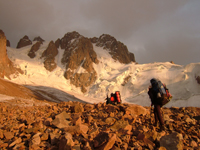 Metallurg Camp led by F. Lemsterm made a traverse going up along the north-western ridge and down to the south-east. Metallurg Camp led by F. Lemsterm made a traverse going up along the north-western ridge and down to the south-east. The history of climbing Talgar was not completed yet. In 1951, A . Alekseyev’s group made a traverse from the south-west to the north, having ascended to the southern top from a sink between the southern and western peaks and descended along the north-eastern ridge.
Conquerors of the first wall of Talgar had thoroughly prepared their route and named a few more of them. However, no serious attempts were made until 1958 to conquer any other wall of Talgar.
In 1958, a team led by Grandmaster I.V. Soloduyev came to Talgar Camp. Soloduyev had a great talent as a violin player of the Bolshoi Theater and as courageous mountain climber. The backbone of the team included young climbers: V. Barzykin, L. Dmitriyev, Yu. Novikov, G. Stepanov, and A. Snesarev. On August 18, 19 58 the group completed the new way on the western wall of the southern peak of Talgar . This route took the 4th place in the U.S.S.R mountain climbing championship and classified as Category 5B.
Every year, the geography of the team trying to win new ways towards Talgar Peak was growing on. In 1962, a group of Latvian climbers took part in the massif climbing. The north-western wall of the south-eastern Talgar was chosen as the point to ascend. The Latvian climbers were storming the wall for five days in severe weather. As a result, a new route was laid out classified as Category 5A. To commemorate the climbers, a nameless peak in the south-eastern branch of Talgar was named Daugava.
In 1968, another Category 5B route was completed, on the same south-western wall of the southern peak of Talgar . The ascending report said: “On the western wall of Southern Talgar, the mountain climbers could not but pay attention to menacing cliffs rising up towards the peak of Southern Talgar, to the right of the route followed by Snesarev’s group. The will to climb those walls appeared back in 1966, during the climbing of “Snesarev’s Wall”. This will was finalized when we were climbing the north-western wall of the south-eastern Talgar while traversing the Talgar Massif. The three days of observing the wall and great pictures of the route confirmed that difficult route could be climbed, both technically and tactically”. The group was led by Grandmaster M. Akimenkov and included 3 first-class climbers: Ye. Belovolov, V. Denisov and Yu. Popenko.
In 1978, Talgar Camp was destroyed by a mudslide which hampered development of this region. It was then only used as a base for stationary groups of climbers to make classification ascends.
In 1991, the region was shut down for visits due to stricter rules of visiting Almaty Reserve as the massif was within its area. It wasn’t until 2000 when the region was open again for visits by tourists and mountain climbers.
|
 |
|
 |
 |
|
|
|
|
 |
|
